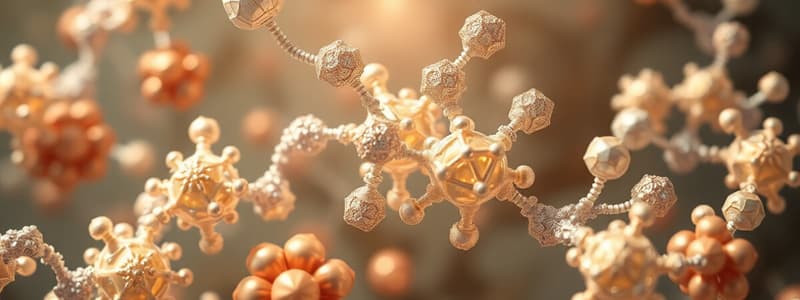Podcast
Questions and Answers
What is the primary function of glucose in the body?
What is the primary function of glucose in the body?
- Storage of genetic information
- Source of energy for respiration (correct)
- Building blocks for nucleotides
- Formation of proteins
Which of the following is a process that joins monomers to form polymers?
Which of the following is a process that joins monomers to form polymers?
- Condensation reaction (correct)
- Dehydration synthesis (correct)
- Oxidation
- Hydrolysis
What type of bond is formed between two monosaccharides during the creation of a disaccharide?
What type of bond is formed between two monosaccharides during the creation of a disaccharide?
- Hydrogen bond
- Ionic bond
- Glycosidic bond (correct)
- Peptide bond
How many carbon atoms does a glucose molecule contain?
How many carbon atoms does a glucose molecule contain?
What is produced when two monosaccharides undergo a condensation reaction?
What is produced when two monosaccharides undergo a condensation reaction?
Study Notes
Monomers and Polymers
- Monomers are small units like monosaccharides (e.g., glucose), amino acids, and nucleotides.
- Polymers are formed by multiple monomers connected through chemical bonds.
- A condensation reaction eliminates a water molecule to join monomers.
- Hydrolysis adds water to break chemical bonds between molecules.
Carbohydrates
- Composed solely of carbon, hydrogen, and oxygen; consist of long chains of sugar units known as saccharides.
- Monosaccharides are single sugar units; disaccharides consist of two monosaccharides.
- Polysaccharides are formed by combining multiple monosaccharides through glycosidic bonds in a condensation reaction.
Monosaccharides
- Glucose, a primary monosaccharide, contains six carbon atoms and is essential for respiration.
- Has two isomers: alpha and beta glucose.
- Other common monosaccharides include galactose and fructose, characterized by sweetness and solubility.
- The general formula for monosaccharides is (C_nH_{2n}O_n) where n ranges from three to seven.
Disaccharides
- Formed from two monosaccharides via a condensation reaction that produces water.
- Example: The combination of two alpha glucose molecules creates maltose through the formation of a 1,4 glycosidic bond.
- Process involves the removal of hydroxyl (OH) groups and produces a water molecule in the reaction.
Studying That Suits You
Use AI to generate personalized quizzes and flashcards to suit your learning preferences.
Description
Test your knowledge on monomers and polymers in biology. This quiz covers concepts such as condensation and hydrolysis reactions, along with examples of various monomers like amino acids and nucleotides. See how well you understand the building blocks of larger molecules.




